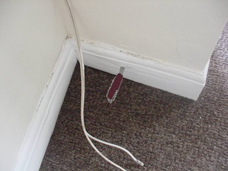Dampness coming through walls
Independent building surveyors
If you have any problems in relation to dampness in your walls please phone us on free phone 0800 298 5424 for a friendly chat.
We are experienced, professional independent building Surveyors who are knowledgeable in carrying out structural surveys on all types, styles and eras of buildings. If you are moving house or having any property issues then an independent Surveyor can help provide a comprehensive survey report.
Why does dampness coming through walls?
There can be various reasons for dampness coming through walls. Firstly we will look at older properties and then in newer properties. Just be aware that newer properties can have as many problems with dampness as older properties, as we generally find that newer properties tend to be built to a price rather than built to a standard.
Dampness in older properties
Generally where a property is brick built or stone built dampness often comes through the walls because they are solid walls, usually in English Bond or Flemish Bond.
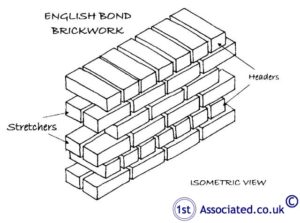
English bond brickwork

Flemish bond brickwork
Soft Red Bricks
The other interesting fact about older brick walls is that they are often in a softer red brick and when they’re in brick or stone they are generally bedded in lime mortar. Both the softer red bricks can weather and so can the lime mortar.
The correct solution for this is to repoint in a like for like lime mortar and not to use a cement mortar as that will damage the bricks, particularly the soft red bricks.
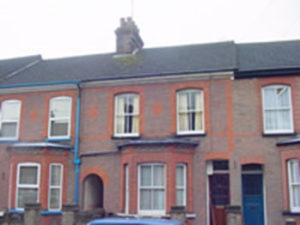
Red brick Victorian house
Other solutions that have happened over the years
Over the years other solutions have been rendering which was alright whilst we used a lime mortar but tends to be a problem as it cracks and can cause deterioration where cement mortar is used. We also tend to find that the detailing isn’t as good with modern render and they miss things like the drip details over the windows and the bell mouth to the base of the render.
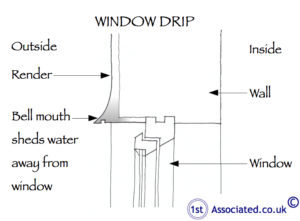
Drip detail over windows
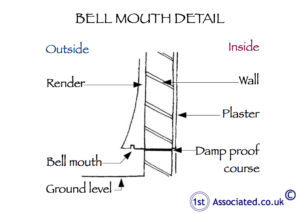
Bell mouth detail at base of render
In the 1960’s/1970’s such things as pebbledash render was used, which was a form of rendering normally in cement, possibly with some lime with pebbledash applied to it. It could be machine applied so the job was only semi-manual which meant it was a lot quicker and was sold as the latest things to prevent dampness.
Other things that have been used over the years are such things as stone cladding, which is basically stuck to the brickwork. It does offer a protective layer but can look strange where the rest of the row of houses are in brick with one in stone.
The worst way to stop dampness on a wall is to repoint in cement mortar
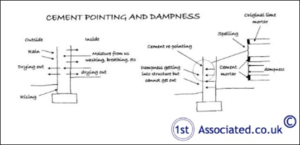
The second worst thing to do to an old wall is to paint it with a modern paint. We were recently disheartened on a wall of one of our properties that we’d been leaving for some time to allow the cement render to come off on its own (when we say some time we had been doing this over a period of around five years) and then the person living in the house decided to paint the exterior without advising us and they had used a plastic based paint, which effectively smothers the wall and causes all sorts of problems with old soft red brick, which is what this was.
Unfortunately unlike the repointing in a cement mortar, painting in a plastic paint is very difficult to get off and tends to cause dampness into a property.
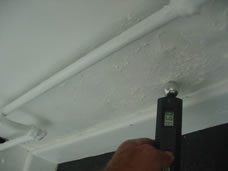
Blistering to plastic based paint.
Damp meter readings show
low levels of dampness.
The whole problem with dampness in a property is that people then often contact ‘specialist damp proof companies’. We say specialist damp companies because many of them we would argue are just selling chemicals that they inject into a wall and chemicals that they put into the external render and internal plaster. We have seen all sorts of problems with these walls where the dampness returns.
We recommend you have an independent building survey
Dampness in newer buildings
Newer buildings will tend to have a Stretcher bond brick construction.
The way a modern wall works is that the outside skin of them all gets wet and is prevented from travelling inside because there’s a gap there and then the outside wall dries out so the inside walls stay dry. However, we’ve found several problems with this.
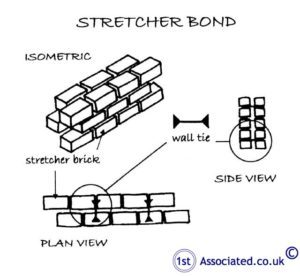
Stretcher bond brickwork
Bricklaying problems you just can’t see
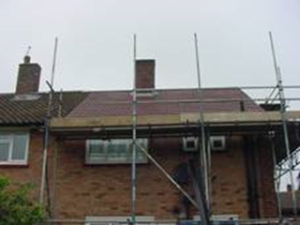
New build property
Adding insulation to cavity walls, is it correct? Can it cause problems?
The other problem we’ve come across is where insulation has been incorrectly added to a cavity wall and this cause caused the dampness to transfer from the exterior of the property to the interior of the property. Again unfortunately the need to sell, sell, sell by the insulation companies means that sometimes they don’t carry out the correct checks and add insulation regardless, causing all sorts of problems.
Change in levels
We sometimes find that dampness can get into properties where there is a change in level of the land. We refer to this as a sloping site and is where the rear wall of the property effectively becomes a retaining wall of the earth and any ground water within it. This can cause dampness to get into the property.
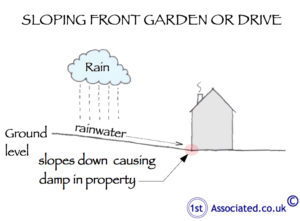
High ground level around a property.
Plants may be growing where
there is dampness.

Sloping site sketch with retaining wall
We shouldn't forget that it was common to have a suspended timber floor like we have shown in the adjoining sketch. Underneath the suspended timber floor you had air movement from the airbricks that were outside the property. This air movement often included air movement up between the floor boards as we didn't have wall to wall carpet, we simply had a carpet for the middle of the floor and the air movement was considerable underneath the property.
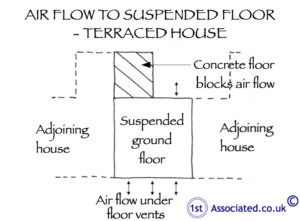
Suspended timber floor
Compare our Building Surveys but don't compare Apples with Thursdays
We have a wealth of knowledge and experience as independent surveyors if you require a building survey or structural survey.
If you would like us to send you a copy of one of our surveys we are more than happy to do this although we fully appreciate all properties are unique therefore making all our surveys unique and tailored to your individual needs.
We have every confidence in our surveys and believe there are no other comparable surveys out there in the UK property and surveying market.
Having a survey carried out on the property by an independent chartered building surveyor will give you extra peace of mind.
All are surveyors are members of the Royal Institution of Chartered Surveyors (RICS) and Independent Surveyors and Valuers Association (ISVA).
What do the ovals or circles in our building surveys mean?
Within our reports we utilise a system of ovals and circles to highlight problem areas or characteristics within a property to better explain the issues. If this does not explain the issue completely then we can also use one of our sketches that have been commissioned exclusively for us for use in the reports.
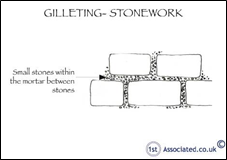
Gilleting stonework sketch
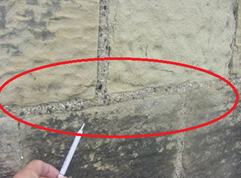
Gilleting between stonework
Meet your building surveyor
We recommend you meet us at the property during the survey so that we understand exactly what you require from your survey report and so we can answer any questions you may have.
Our Surveying Articles
Here are a few articles we recommend you read regarding dampness and walls.
Render problems
How, in our opinion, insurance companies deal with cracking
Condensation, mould and air movement in houses
To see more surveying articles on our Free Property Articles page or phone us on 0800 298 5424.
We can talk and talk about property
We hope you found the article of use and if you have any experiences that you feel should be added to this article that would benefit others, or you feel that some of the information that we have included is wrong then please do not hesitate to contact us (we are only human).
All rights reserved to 1stAssociated.co.uk
All rights are reserved the contents of the website are not to be reproduced or transmitted in any form in whole or part without the express written permission of www.1stAssociated.com


